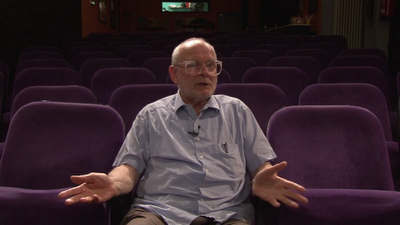Video essay-tribute by Catherine Grant
The above is a very short study of a sequence from Diálogos de exiliados/Dialogues of Exiles (France, 1974/5), an extremely low-budget film written and directed in Paris by the late and much lamented Raúl Ruiz. Diálogos was the first film to be made by that filmmaker in exile from Chile, with many of his countrymen and women, after Augusto Pinochet's 1973 coup d'état against the legally elected Popular Unity government of Salvador Allende. Controversially, at the time, it wasn't exactly the most conventional, or, despite its satire, the most crowd-pleasing 'exile' or 'solidarity' film that could have been made in those circumstances. And yet, as Zuzana Pick wrote of it, "[Diálogos] can fulfill the function that Ruiz intended for it by provoking dialogue. With its clear and evocative title, this first work of Chile’s cinema of resistance inserts itself into the struggle against fascism."
Shortly after that list appeared, though, FSFF's author was asked for a more personal response to the work of one of her favourite film artists: to contribute some thoughts on a beloved moment in Ruiz's films to a wonderful collection of such thoughts -- by critics, academics, and people who knew the Chilean filmmaker -- currently being published in serial form at the MUBI Notebook.
This was how the above, little video tribute came into being. The links to all the contributions are being added below as they, also, appear online.
Many thanks to David Phelps for his wonderful work of commissioning and curation. It was a real pleasure, albeit quite a poignant one, to take part, and an honour to have one's work published in such excellent, international company.
- Chilean Memories by Jeronimo Rodriguez (En español, coming soon)
- Don Raúl's Ruizness by Gonzalo Maza (En español, coming soon)
- La maleta (1963/2008) by T.C. Smith
- Diálogos de exiliados (Dialogue of Exiles, 1975) by Catherine Grant (video essay)
- Colloque de chiens (Dog’s Dialogue, 1977) by Maxim Pozdorovkin
- On Top of the Whale (1981) by James Quandt
- City of Pirates (La ville des pirates, 1983) by Ignatiy Vishnavetsky
- Point de fuite (1984) by Gina Telaroli
- Mammame (1986) by Joe McElhaney
- Brise-glace (1989) by Luc Moullet (in English and French / en anglais et français)
COMING SOON
- The Golden Boat (1990) by C. Mason Wells
- Poetics of Cinema (1994/2005) by Matthew Flanagan
- Shattered Image (1998) by Zach Campbell
- “Los dos caminos” / “The Two Paths” by Cristián Sánchez Garfias
- Time Regained (Le temps retrouvé, 1999) by David Pendleton
- Cofralandes, Chilean Rhapsody (2002) by Quintín
- Klimt (2006) by Adrian Martin
- A Closed Book (2010) by David Phelps
- Mysteries of Lisbon (2010) by Carlos Losilla






